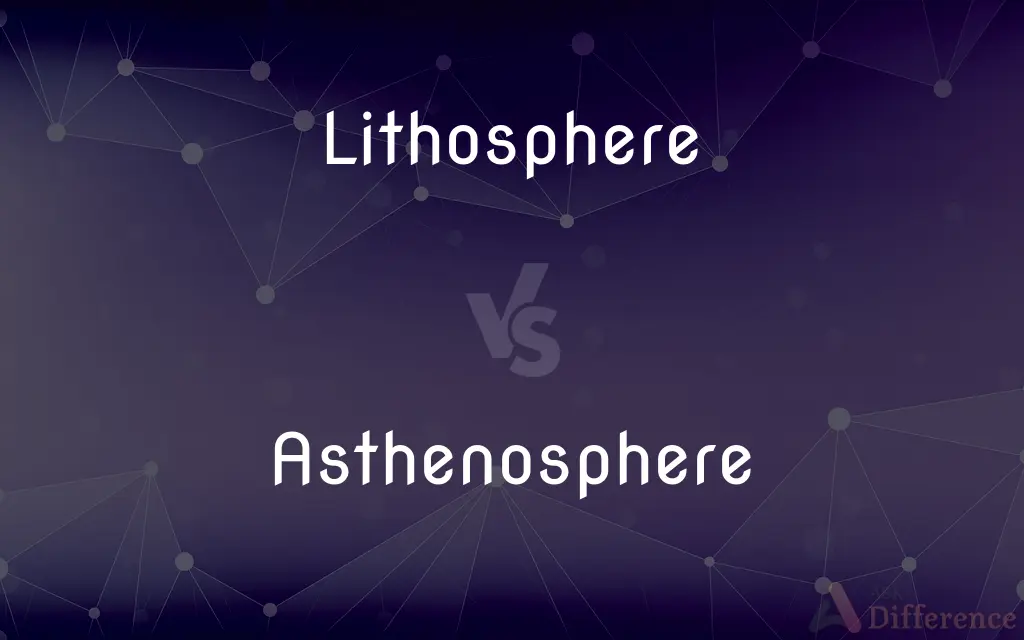Lithosphere vs. Asthenosphere — What's the Difference?
Edited by Tayyaba Rehman — By Fiza Rafique — Updated on March 16, 2024
The lithosphere is the rigid outer layer of the Earth, composed of the crust and upper mantle, whereas the asthenosphere is a highly viscous, partially molten layer beneath it, facilitating tectonic movements.

Difference Between Lithosphere and Asthenosphere
Table of Contents
ADVERTISEMENT
Key Differences
The lithosphere encompasses the Earth's crust and the uppermost part of the mantle, forming a rigid layer known for its stability and solidity. On the other hand, the asthenosphere lies directly beneath the lithosphere, characterized by its semi-fluid nature and ability to flow slowly, which is essential for the movement of tectonic plates.
While the lithosphere varies in thickness, being thicker under continents and thinner under oceans, the asthenosphere maintains a relatively consistent thickness and is known for its plasticity. This plastic nature allows it to act as a lubricating layer over which the lithosphere can move.
The lithosphere's rigidity is due to its cooler temperatures and lower pressure, making its rocks brittle and less able to flow. In contrast, the asthenosphere's higher temperature and pressure conditions render its rocks more ductile, allowing them to deform and flow without fracturing.
Tectonic plates, consisting of the lithosphere, are involved in processes like continental drift, mountain building, and earthquakes. The asthenosphere, however, plays a crucial role in plate tectonics by enabling the movement of these plates, acting as a soft layer that allows the lithosphere to slide over it.
The lithosphere's interaction with the asthenosphere is pivotal in understanding Earth's geodynamics, including volcanic activity and seafloor spreading. The asthenosphere's viscosity and flow properties are key factors that influence these dynamic geological processes.
ADVERTISEMENT
Comparison Chart
Composition
Crust and upper mantle
Upper mantle
State
Rigid and solid
Semi-fluid, partially molten
Role in Plate Tectonics
Comprises tectonic plates
Facilitates plate movement
Thickness
Varies, thicker under continents
Relatively consistent, thinner
Temperature and Pressure
Cooler, lower pressure
Hotter, higher pressure
Compare with Definitions
Lithosphere
The lithosphere is Earth's outermost layer, including the crust and part of the mantle.
The Earth's continents are part of the lithosphere.
Asthenosphere
Its semi-fluid nature facilitates the movement of the lithosphere.
The Hawaiian Islands were formed by the asthenosphere's dynamics.
Lithosphere
Composed of several tectonic plates, the lithosphere covers the Earth's surface.
The Pacific Plate is one of the largest lithospheric plates.
Asthenosphere
The asthenosphere is a ductile layer beneath the lithosphere, crucial for plate tectonics.
The asthenosphere's flow allows the continents to drift.
Lithosphere
It is characterized by its rigidity and involvement in tectonic activities.
Earthquakes occur due to movements within the lithosphere.
Asthenosphere
Despite its high viscosity, the asthenosphere can flow slowly.
The slow movement of the asthenosphere affects Earth's surface features.
Lithosphere
The lithosphere's thickness varies, being greater under continents.
The lithosphere under the Himalayas is exceptionally thick.
Asthenosphere
The asthenosphere is composed of partially molten mantle material.
Seismic waves slow down when passing through the asthenosphere.
Lithosphere
The lithosphere interacts with the asthenosphere, influencing geodynamics.
Volcanic eruptions are often a result of lithospheric movements.
Asthenosphere
The asthenosphere's depth varies, generally found below the lithosphere.
In some regions, the asthenosphere is closer to the Earth's surface.
Lithosphere
A lithosphere (Ancient Greek: λίθος [líthos] for "rocky", and σφαίρα [sphaíra] for "sphere") is the rigid, outermost shell of a terrestrial-type planet or natural satellite. On Earth, it is composed of the crust and the portion of the upper mantle that behaves elastically on time scales of thousands of years or greater.
Asthenosphere
The asthenosphere (Ancient Greek: ἀσθενός [asthenos] meaning "without strength", and thus "weak", and σφαίρα [sphaira] meaning "sphere") is the highly viscous, mechanically weak, and ductile region of the upper mantle of Earth. It lies below the lithosphere, at depths between approximately 80 and 200 km (50 and 120 miles) below the surface.
Lithosphere
The outer part of the earth, consisting of the crust and upper mantle, about 100 kilometers (62 miles) thick.
Asthenosphere
A zone of the earth's mantle that lies beneath the lithosphere and consists of several hundred kilometers of deformable rock.
Lithosphere
(geology) The rigid, mechanically strong, outer layer of the Earth; divided into twelve major plates.
Asthenosphere
(geology) The zone of the Earth's upper mantle, below the lithosphere.
Lithosphere
The solid earth as distinguished from its fluid envelopes, the hydrosphere and atmosphere.
Asthenosphere
The lower layer of the earth's crust, below the lithosphere. It is estimated as from fifty to several hundred miles thick. It is less rigid than the lithosphere, but still rigid enough to transmit some transverse seismic waves.
Lithosphere
The solid part of the earth consisting of the crust and outer mantle
Asthenosphere
The lower layer of the crust
Common Curiosities
How do the lithosphere and asthenosphere interact?
The lithosphere floats on the asthenosphere, which facilitates the movement of tectonic plates due to its semi-fluid nature.
What makes the asthenosphere different from the lithosphere?
Unlike the rigid lithosphere, the asthenosphere is partially molten and ductile, allowing it to flow slowly.
What is the lithosphere?
The lithosphere is the rigid outer layer of the Earth, comprising the crust and the upper part of the mantle.
What is the asthenosphere?
The asthenosphere is a viscous, semi-fluid layer beneath the lithosphere, important for the movement of tectonic plates.
Why is the lithosphere rigid?
The lithosphere is rigid due to its composition of cooler and less pressurized rocks, making it solid and stable.
What role does the asthenosphere play in plate tectonics?
The asthenosphere acts as a lubricating layer that allows the lithosphere's tectonic plates to move.
Can the lithosphere be found under the ocean?
Yes, the lithosphere includes the oceanic crust and extends beneath the oceans.
What happens at the boundary between the lithosphere and asthenosphere?
At this boundary, the lithosphere's rigid plates interact with the more fluid asthenosphere, leading to geological activities like earthquakes and volcanic eruptions.
How thick is the lithosphere?
The lithosphere's thickness varies, being thicker under continents and thinner under oceans.
How does the lithosphere affect the Earth's surface?
The lithosphere directly influences the Earth's surface through the formation of mountains, earthquakes, and volcanic activity.
What would happen if the asthenosphere didn't exist?
Without the asthenosphere, plate tectonics and the dynamic surface processes associated with it would not occur.
Is the asthenosphere found everywhere beneath the lithosphere?
Generally, the asthenosphere is found beneath the lithosphere, but its depth and thickness can vary depending on geographical location and geological conditions.
How do scientists study the asthenosphere?
Scientists use seismic studies and indirect observations to study the asthenosphere's properties and behavior.
Why is the asthenosphere important for Earth's geodynamics?
The asthenosphere's physical properties allow for the lithosphere's movement, influencing volcanic activity, seafloor spreading, and continental drift.
Are there different types of lithosphere?
Yes, there are two types: oceanic lithosphere, which is denser and thinner, and continental lithosphere, which is thicker and less dense.
Share Your Discovery

Previous Comparison
Hummer vs. Hammer
Next Comparison
Syphilis vs. HerpesAuthor Spotlight
Written by
Fiza RafiqueFiza Rafique is a skilled content writer at AskDifference.com, where she meticulously refines and enhances written pieces. Drawing from her vast editorial expertise, Fiza ensures clarity, accuracy, and precision in every article. Passionate about language, she continually seeks to elevate the quality of content for readers worldwide.
Edited by
Tayyaba RehmanTayyaba Rehman is a distinguished writer, currently serving as a primary contributor to askdifference.com. As a researcher in semantics and etymology, Tayyaba's passion for the complexity of languages and their distinctions has found a perfect home on the platform. Tayyaba delves into the intricacies of language, distinguishing between commonly confused words and phrases, thereby providing clarity for readers worldwide.
















































